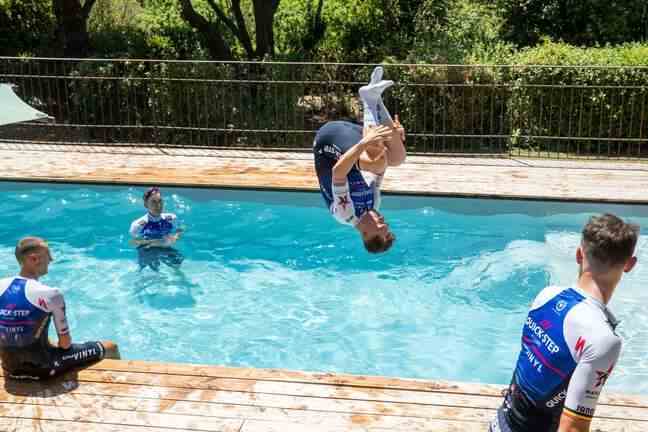The 15th stage of the Tour de France, Sunday, turned to “hell” (dixit Romain Bardet) between Rodez and Carcassonne. For nearly 200 kilometres, the riders rode under a real dodger, with peaks at over 40°C. “I love my job, but in these conditions it was very, very difficult”, breathed Mikael Cherel on arrival, well burnt but perhaps not as much as Tom Pidcock, who threw himself shirtless into the fountain closest from the past line.
In the team cars, we didn’t necessarily have a better day. The logistics of refueling the runners sometimes turns into a headache. “You have to multiply the bogus points on the course, every 20-30 km, explains Alain Deloeuil, the sports director of Cofidis. It requires staff, cars, and then you have to have ice cubes available all the time, it’s a whole organization. »
Watering holes for runners?
Although the peloton will head towards the Pyrenees this week, and thus lose a few degrees with the altitude, the problem may unfortunately arise again in the years to come. We won’t tell anyone (well, we hope) that the summers are going to get hotter and hotter. So how can the Tour continue to take place without putting the lives of the riders in danger? Because that’s what it’s all about. “I would not have liked to be in the place of the organizers if a runner had had a cardiac arrest”, launched the Belgian Philippe Gilbert this Monday morning in The Team.

Among the short-term solutions, the race management (in agreement with the UCI) authorized refueling from the start and up to 10 kilometers from the finish, lifted the penalties for throwing cans towards the spectators and lengthened the delays by 20%. Another idea that is not too complex to implement is to provide watering points for the runners. It was mentioned by some sports directors, including Marc Madiot, with the technical director of the Tour Thierry Gouvenou.
In this regard, the boss of Groupama-FDJ was pissed at the controversy born of the video showing the watering of the road before the passage of the riders on Sunday. Rumor has it that 10,000 liters of water were spilled to cool areas where the tar was melting. Race management clarified that it was actually some 200 meters in total, requiring around 300 liters of water – the equivalent of three bathtubs. Since the start of the Tour, this opener truck called “Gros Léon” has been used on three stages, explained the “Mister Road” of the Departments of France André Bancala to AFP.
“If we were dealing with animals, we wouldn’t even ask ourselves the question of putting them in good conditions, thundered the Mayenne during a press briefing organized at the start of the afternoon. These are a few liters of water, it is very disappointing that so little interest is paid to the well-being of the runners, when there are 8 or 9 million television viewers in France every day. »
Beyond these arrangements to deal with the most urgent, changes of greater magnitude seem inevitable. The stages could thus be shortened, to finish with the 220 kilometer tunnels to explode the pot. A well-packed stage of 140 terminals can do just as well for the show. Disadvantage, the impact on the route. Or how to offer a varied route, in as many regions as possible, with 2,500 kilometers on the clock rather than 3,300. “Or else there would be a lot more transfers, so a lot more buses in the evening, in the morning… it’s not ideal for anyone,” says Alain Deloeuil.
A balance between the health of the runners, the athlete and the commercial requirements
Another idea, what about a stage start in the morning, for example, when the heat wave is announced? “Perhaps, yes,” replies Marc Madiot. His Cofidis counterpart is dubious about the feasibility. “It’s tricky, because we also depend on television. The public is in front of its TV in the afternoon rather than in the morning. It seems difficult to me. »
The Northerner scores a point. The Tour de France is an enormous machine with planetary resonance, of which we are not going to upset all the mechanics of a snap of the fingers. “The health of the runners is the priority, but we know that it is a question of balance between that, the athlete and the commercial requirements”, he continues.
Changing the date of the Tour, out of the question for sports directors
What makes it that moving the biggest race in the world to April or October is “utopian”. “The Tour is the month of July, the annual meeting place for holidaymakers who come to see the caravan, the peloton. Imagining that during the working period is to ask the question of its interest, develops Deloeuil. And then it would involve a total overhaul of the calendar. The Grande Boucle has not taken place in July once since the end of the Second World War, in 2020 because of the Covid.
Marc Madiot agrees on this point: “The Tour is still the major event of the summer. It’s an important meeting for many people who are on vacation, who can’t leave or who are in retirement homes. It’s a bit of happiness that we bring them, we have to try to keep the race going during this period. The organizers will have to show imagination, in any case, to continue to guarantee the show.
The boss of Groupama-FDJ is not trying to minimize the urgency. “I have been present on the Tour for many years, this is the first time that I have encountered such perilous situations, recognized Madiot. We won’t be able to repeat days like yesterday [dimanche]. The runners showed a lot of courage, but these are things you can only do once in a while, not every day. »

